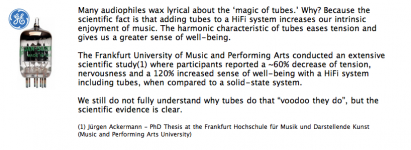Why the peanut gallery insists you can't hear distortion 100 db down. So these capacitors will work just great in their gear.
Samuel showed ordinary commercial caps at -160dB, why did this de-evolve into JC rolling out old 40yr. old measurements of bad capacitors? The story is over.
Now would you care to discuss the difference between charge propagation and electron drift?
This is your key problem. There is no charge propagation in this context.
Thought experiment 2, A signal generator has two terminals i.e. it completes a circuit. When, for instance, it outputs a 100ns pulse current goes out the output and exactly the same current returns through the common for 100ns. There IS NO CHARGE transfered to the system.
I suppose this could all be a put on, good for you.
Of course, I was measuring a Tantalum cap.
And apparently measuring them without a bias voltage. Were the cap measurements Scott mentioned of tantalum caps measured without any bias voltage? Who on earth would use an non-biased polar cap for passing audio?
Again, my point was that it was rather disingenuous of you to do such a thing in response to his post.
se
Samuel showed ordinary commercial caps at -160dB, why did this de-evolve into JC rolling out old 40yr. old measurements of bad capacitors? The story is over.
I believe the measurements John posted were made recently using his new toy.
se
I believe the measurements John posted were made recently using his new toy.
se
Noted - still a rehash.
Noted - still a rehash.
Was worse than a rehash. It was grossly misleading.
se
And apparently measuring them without a bias voltage. Were the cap measurements Scott mentioned of tantalum caps measured without any bias voltage?
Who on earth would use an non-biased polar cap for passing audio?
se
As incredulous as it seems, it appears that a lot of companies still do this. A polar coupling cap between opamps, for example.... no bias on them. I have schematic of a new product ( selling for about $800-1000 USD) of well known name that does this.
-RM
Last edited:
Read my paper, hitsware. I actually found a novel solution at the time. (1978)
NOW, I just direct couple and avoid the problem entirely.
NOW, I just direct couple and avoid the problem entirely.
How about back to back tantalums ?
(little or no bias)
A lot better. However, there are some pretty good bi-polars now. I have good results with Panasonic brand for their polar electro and bipolar. Available from Digi-Key.
-RNM
tubes
Soft and soothing to kill those jittery nerves... always works.
-THx RNMarsh
As incredulous as it seems, it appears that a lot of companies still do this. A polar coupling cap between opamps, for example.... no bias on them. I have schematic of a new product ( selling for about $800-1000 USD) of well known name that does this.
Crazy. And I assume you can't spill the beans on which company it is?
se
The new Elna Silmic caps are my aluminum electrolytic fave at the moment.
Gotta love the "Engrish."
- To relieve the music's vibration energy.
- To decrease the peak feeling sound at high compass and rough quality sound at middle compass.
- To increase massive sound at low compass.
se
tubes
Did they include live music in the comparison?
But Scott,
All those electric guitars playing through tube powered amps with Marshall stacks are very soothing to the soul! 😀
All those electric guitars playing through tube powered amps with Marshall stacks are very soothing to the soul! 😀
I have found Silmics from 5 years ago to sound pleasant.The new Elna Silmic caps are my aluminum electrolytic fave at the moment.
Anything different about the new ones ?.
Dan.
But Scott,
All those electric guitars playing through tube powered amps with Marshall stacks are very soothing to the soul! 😀
Nothing like watching Jimi walk up to his wall of Marshallls and turning them all up to 11.
- Status
- Not open for further replies.
- Home
- Member Areas
- The Lounge
- John Curl's Blowtorch preamplifier part II
